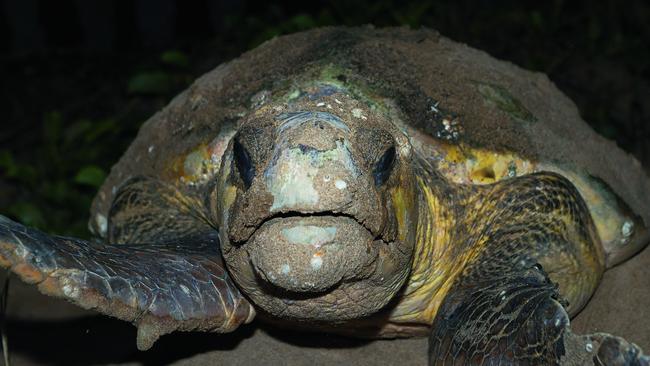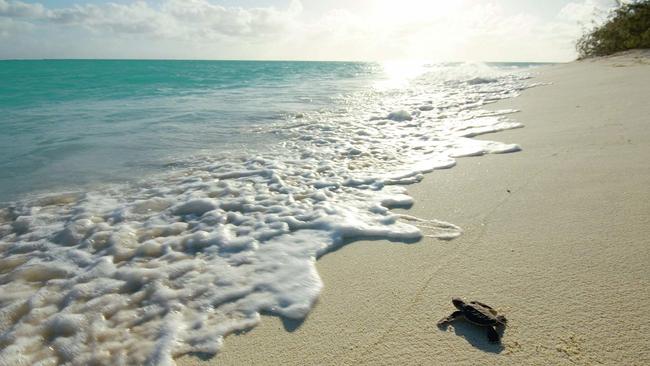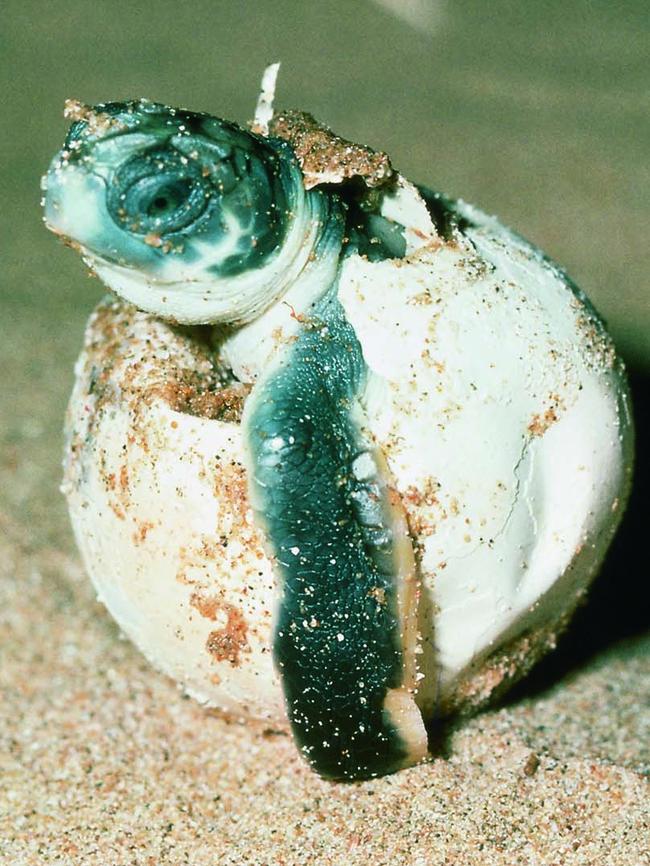Turtle watching at Mon Repos and Heron Island, Queensland
For two wide-eyed girls, a visit to prime turtle-breeding territory is unforgettable.

She came the long way, a 30-year round trip she made alone, riding the ocean highway of the East Australian Current back when she was a loggerhead hatchling no bigger than a cake of soap, tossed and spun for 20,000km past Lord Howe Island and the northern tip of New Zealand across to the vast blue waters of coastal Chile and Peru, then boomeranged back home on the swirling currents of the South Pacific Gyre.
We took the short cut, four hours’ drive north in a Toyota Corolla, Brisbane to Bundaberg via four meat pies with peas. It was 7pm when we arrived at the Mon Repos Turtle Centre, the most significant loggerhead turtle rookery in the South Pacific. It was 10pm — we would have waited well past midnight to see her, and thousands do every year — when a Mon Repos ranger informed our group that, like thousands of loggerhead mums before her dating back 40 million-plus years, she had somehow made it back to the 2km-long yellow sand beach of her birth to lay her own eggs. She had done what only one in 1000 of her kind survive long enough to do. She came home.

“Look, she’s crying,” a young girl on the beach whispers, kneeling in the dark night dunes where our group of 20-odd people have formed a safe-distance circle around this unfolding and miraculous phenomenon. And it’s tempting to imagine for a moment that she’s weeping for the wonder of it all; mum tears, happy tears, awed tears like the ones running down the cheeks of that American woman standing across from me. The turtle’s able to drink salty water to hydrate, our ranger says. She excretes high concentrations of salt through glands near her eyes and these excretions look like rivers of tears.
Something so alive about all this, something raw and electrified. This beach at night. Darkness but for distant flashes of lightning. Light rain on our heads and this magnificent mother, a metre long and her yellow-brown shell telling her solitary life story in its dents and scratches, laying white ping-pong ball eggs inside a deep sand chamber she has laboriously dug before our eyes with a flurry of sand-flinging slaps from her limbs. And you watch your own two daughters watching her and you hope they comprehend the genius of her, the big things she’s come to teach them about tenacity and finishing what you start and why it always pays to switch off those infernal screens.
There’s minimal artificial light here. The turtles don’t like it. The rangers of Mon Repos (“my rest” in French) speak of a campaign to reduce the electric glow that emanates from buildings and shops in the neighbouring town of Bargara, where we’ve been staying in the family-friendly Kelly’s Beach Resort, 8km from the Mon Repos Conservation Park. The loggerheads nest and hatch in the cover of darkness, but are vulnerable to disturbance and disorientation from the lights.
“I just want my grandkids to enjoy this thing I enjoy so much,” says Dr Col Limpus, the pioneering marine scientist celebrating his 50th continuous year of largely night-time research in Mon Repos. It was Limpus who ensured the survival of this place, fought tooth and nail to heritage-protect a place where once upon a time beach-partying locals rode these precious dinosaur loggerheads like donkeys; he turned it into the largest protected concentration of nesting marine turtles on the eastern Australian mainland. He speaks of a flatback turtle — “X23103” — he tagged in 1978, an “old girl” more than 60 years old, who still returns to Mon Repos. It’s about life cycles, says Limpus. Tired hatchlings become tireless mother loggerheads. Wide-eyed kid tourists become keen adult thinkers.
My girls watch the glorious loggerhead cover her eggs with sand then trudge, slow and spent, back into the dark ocean.
“Well, how good was that!” I gush on the drive back to Bargara.
“Amazing,” says my 10-year-old daughter. “Imagine what it’s like to see a hatchling!”

Imagine Heron Island. A tiny sand and tree island that rose 6000 years ago out of the Great Barrier Reef, a two-hour boat ride off Gladstone, which is only a two-and-a-half-hour drive north from Mon Repos via a mud crab sandwich at the Miriam Vale Garage. A coral cay home to black noddy terns and eastern reef egrets and wedge-tailed shearwaters and birds from the northern Arctic that battle impossible winds for endless kilometres just to rest amid the island’s native mulberry trees and sandpaper figs and native elms and dense Pisonia forests. Some divine island for twitchers and scientists and Gods and kids.
“What does that look like?” says naturalist guide Rachael Jones, leading my eight-year-old daughter’s eyes to a sea slug beneath a clump of coral on a low tide reef walk at sunrise.
“It looks like a sausage,” my daughter says.
Rachael, one of the many enthusiastic and brilliant marine biologists who make up Heron Island’s staff, turns the slug upside down in her hand, showing its blackened underside.
“It’s called a ‘burnt sausage sea cucumber’,” she says. My daughter beams. Rachael spots something in the distance. “Aahhh, found it,” she says. “There’s our path.” A perfect path as wondrous as Dorothy’s yellow brick road winding through the reef cluster and leading us to a crystal clear “lagoon” within the cay where we snorkel amid sea stars and epaulette sharks and banded humbug fish and black saddled tobies and hermit crabs and juvenile black tip reef sharks.
The Great Barrier Reef can be seen for the first time only once. A kid can swim underwater past an algae-eating green turtle for the first time only once. A kid can scream through her snorkel tube at a passing lemon shark, mostly harmless but bone-rattlingly imposing, for the first time only once. All these creatures own this place. It’s their island; we just sip cocktails on it before sumptuous seafood and roast meat dinners. There can be 100,000 birds here in summer and just as many bird droppings. The trees feed the birds and bird droppings feed the trees and so on. A noddy tern might die and be absorbed into the Pisonia tree and the dead bird’s nutrients help make a stronger home for the dead bird’s relatives.

Cycles of life. This whole imperfectly perfect island is an education. It’s rambling and messy and illuminating like life should be. We sleep in well-maintained rooms built into the Pisonia forest and green turtles shuffle up to the dunes by our bedrooms at night to lay their eggs.
At sunset, there’s a woman walking barefoot down the beach. This is when the dune-buried turtle eggs hatch. “There’s a hatchling down there,” the woman says, pointing to a corner of the island called Shark Bay. We gasp with excitement. “But, you might want to prepare your kids,” she says, lowering her voice. “It’s … deformed.”
Along the beach we find an older couple of tourists standing over a green turtle hatchling that’s making a laboured odyssey across the sand towards the reef waters. Its left forelimb is underdeveloped and its orientation is skewed, heading diagonally across the beach rather than straight down to the water. The tide is falling rapidly now; its stronger siblings made it to the water’s edge long ago. The little fighter pads along for 30 agonising minutes in the setting sun and my girls fall to their knees to carve smooth pathways for it with sticks. I tell the girls it’s getting dark and we have to go because they don’t want to see what will happen when the turtle reaches the water. A lot of hatchlings make it but some don’t, I say, that’s why there’ll be more mums here tonight laying eggs. But the girls don’t want to leave it. One woman can’t stomach the sight of the struggle anymore and she picks the turtle up even though she knows she’s not supposed to; she runs the exhausted hatchling in her cupped hands to the water’s edge.
“You sure you want to stay for this?” I ask the girls. “You know it can’t make it.”
They nod. They know. But they stay by the water’s edge because they look for the positive in anything, for better or worse.
“Go!” my youngest daughter screams. “Swim! Swim!” The hatchling propels itself with only three working limbs. All fight, all spirit, it covers five long metres before a seagull makes a high bombing run from the trees, plucking the hopeful hatchling from the water and carrying it off.
And I’m sure my youngest daughter will cry now but she doesn’t because this magical island has taught her not to. Besides, over by a distant dune her mum is waving her hands, trying to get our attention. She’s spotted three hatchlings emerging from their chamber late, full of life and strength. It’s getting dark and the predatory birds have moved on. My girls rush to these speedy hatchlings and pump their fists, cheering them along a clear 50m run to the water’s edge.
The waterborne hatchlings kick their limbs with a flurry of movement, finding their way through the little reef streets that lead to ocean current highways. And there’s some new-found wonder in the faces of my kids now, something deep and radiant as they stare out across that big and mysterious ocean.
Heron Island, from $379 per night, heronisland.com; Mon Repos Turtle Encounter Tours, $12.40 adults, $6.45 children. More: bundabergregion.org/turtles

